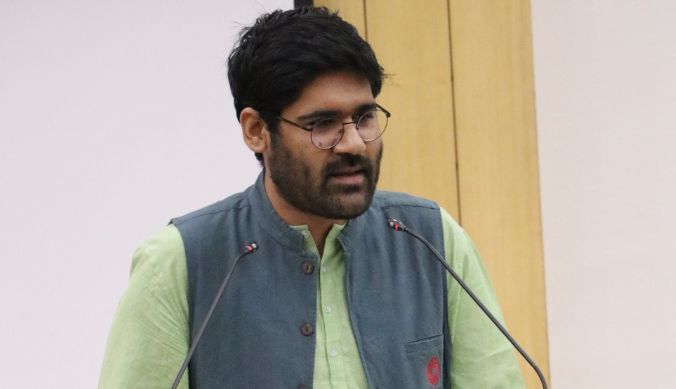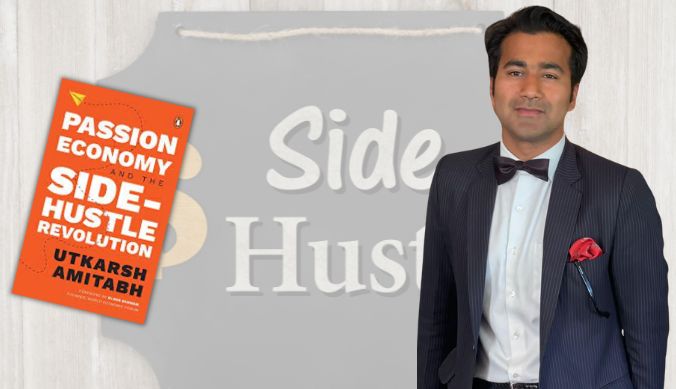‘Once Upon a Time: A Life in Stories’
Featuring Shubham Gupta’s creative piece that developed as an original project over his term at the Young India Fellowship

Shubham Gupta
27 September, 2022 | 4m readAbstract:
Shubham Gupta convinces his readers of the power of imagination and how stories help us to access our emotions and make sense of our mundane experiences. He shares some enchanting stories from his life and ends on a deeply philosophical note that prods us to think beyond life and death.
Article:
Look up but avoid eye contact. Keep walking, keep walking. Swerve left to give way to the girl in a hurry. A slight nod to the right to acknowledge the warmth of the sunshine on the campus lawns. A lapse of judgement resulting in an exchange of awkward half-smiles with an acquaintance. Walk faster. Stop. Then earphones. Unlock. Scroll, scroll. Press play. A momentary blindness. Then the words flow.
When I was seventeen
My mother said to me
“Don’t stop imagining. The day
that you do is the day that you
die.” (Lagoon)
Trevor Powers did not write this song for me. I do not know him or his wise mother. I only know a few things. His music project was called Youth Lagoon. This song is called “17”, from an album called The Year of Hibernation. He wrote it when he was 20 or 21, suffering from anxiety and an acute fear of death. The nostalgia for a recent past, pregnant with the poetry of his mother’s words, gave him a release. The death of imagination is the death of the soul, of the heart, of the human being. We are merely mortal, but stories last. Don’t stop imagining. Don’t stop imagining. Trevor Powers did not write this song for me, but his voice rings in my head, telling me to look for magic in everyday things.
The final panel of my favourite comic strip goes something like this. Disgruntled by the limits of the world we inhabit, Calvin lies down flat on the ground, defeated, and exclaims to Hobbes, “Reality continues to ruin my life” (Waterson). In six words, this existential six-year-old captured the essence of storytelling. Reality is what happens to us. You fail an exam, you lose that girl, you flick through the daily newspaper, you die in a war, you get through yet another day at work, you exist, you exist, you exist. By virtue of its very definition, reality is humdrum. It is objective and straightforward. The human mind, fortunately, likes subjectivity. It likes to think in stories. If reality is what happens to us, stories are how we respond to those happenings.
Why do we cling to stories? There are many reasons. For some, it is a need to disassociate from reality, stemming from a place of dissatisfaction. The mind immediately wanders to Life Is Beautiful, the heart-warming, heartbreaking Italian film set in the Nazi concentration camps. How do you forget Guido and the stories he makes up to protect his son from the horror of the reality that surrounds them? It is easy to dismiss it all as a lie, as a fabrication of the truth. It takes far more courage to believe in a little bit of magic. Stories are not detached from what is real; for many of us, they shape our very realities. Some of us seek stories because of curiosity. You walk into a dark movie theatre, settle down on a nice seat with your warm popcorn, and for a little while, you escape. In a moment, you are in the Millennium Falcon with Han Solo and Chewbacca, fighting for intergalactic peace. Or perhaps it is midnight in Paris and you’re lost in the vagaries of the high society of the 1920s. Spare a moment and look at the beach. Sam Shakusky and Suzy Bishop are dancing to Le Temps de l’Amour. In a moment of self-awareness, you recoil. There is the hint of magic again. You are caught in the world of stories.
Each story-world may seem infinite, but each story begins somewhere. My own obsession with stories too has a genesis, albeit one that is itself scattered across a couple of stories. The first is The Tale of the Two Libraries. It goes like this.
In primary school, we had a library period. Each week, we sat in that cramped library, poring over the likes of Tinkle, Chandamama, Champak, and other assorted magazines. It was the most fascinating thing in the world for a boy like me. Those 40 minutes went by faster than I would have liked. At the end of it, we were issued a book. The process, however, was unique. The librarian picked up a stack of books and put them on her desk. We students formed an orderly line. As we walked up to the desk, we were assigned whichever book was at the top. In the boundaries of this tiny library in the middle of the chaos of New Delhi, the naïveté of youth excused us from the concept of choice. Funnily enough, I did not mind. Money was not abundant at home, so the idea of getting to read a different book each week was good enough for me. I diligently read whatever I was issued. As proof of us having read what we were issued, we were required to submit a short summary each week.
For most of my classmates, reading was an unnecessary infliction on their playtime. Thus, the blurbs present at the back of the book were blindly copied and submitted. Even at the age of ten or 12, this was an absurd idea for me. Instead, I began writing reviews. This impressed the librarian. An honour was bestowed upon me: every week, I could choose my own book. This had an immense impact on me. Soon, I was browsing the shelves, getting my hands on the likes of Oliver Twist, Huckleberry Finn, Black Beauty, Twenty Thousand Leagues Under The Sea, The Famous Five, and so on. That library became my favourite place in the world. When we moved on to the middle school library in seventh grade, I was heartbroken. Then one Friday, things changed.
As the school bus trundled homewards, I threw a cursory glance outside the window. An old, beat-up van snaked its way into a tiny alley. On its side were plastered the following words— “Delhi Public Library Mobile Van”. Upon reaching home, an enquiry was immediately commissioned. Within 30 minutes, I was browsing through the dusty shelves of that mobile library, leafing through tattered copies of the Hardy Boys series. A new Friday ritual began. By 3 pm, I was back home from school. By 3:30, I was rushing towards the van. Then a sigh. A hasty browsing. A revelation. Then the run back home, towards the couch. A restriction on movement and chaos until the last page was over. Then the longing for a new book, a new story. Eventually, the longing got the better of my morality. Lies were told, credentials were forged, and soon, I had two subscriptions to the Delhi Public Library in my name. The Hardy Boys Mysteries consists of a total of 190 volumes. A conservative estimate tells me that I have read at least 70 of them, almost all of them from the insides of the tiny van that would roll up every Friday at 3 pm. It also introduced me to the world of Sherlock Holmes, Agatha Christie and Jeffrey Archer. This boy was dreaming of picnics in the English countryside, of the elegance of elaborate dinner parties, of the dampness and mystery of Baker Street, of the loneliness of prison cells, all from the confines of The Couch That Didn’t Move. The two libraries shaped me and my thinking. They taught me the power of imagination. All I had to do was allow myself to believe in their magic. Thus concludes The Tale of the Two Libraries.
The second story involves a strange word. Sonder. Es oh en dee ee aar. Sonder. The first interesting thing about this word is that it is made up. The second thing is that its place of origin is a blog on Tumblr. Here is the definition of ‘sonder’, as proposed by The Dictionary of Obscure Sorrows:
In the realization that each random passerby is living a life as vivid and complex as your own—populated with their own ambitions, friends, routines, worries and inherited craziness— an epic story that continues invisibly around you like an anthill sprawling deep underground, with elaborate passageways to thousands of other lives that you’ll never know existed, in which you might appear only once, as an extra sipping coffee in the background, as a blur of traffic passing on the highway, as a lighted window at dusk. (Koenig)
When I was struggling in engineering school, the literary club on campus proved to be a haven. It was one of the few places on campus that respected imagination, which was not surprising in a college where innovation was preached but not practised. It allowed me the space to express myself in whatever way I felt, with elaborate puns and terrible poetry soon becoming my speciality. When I became editor of the annual magazine, ‘sonder’ came to me when I was scouring for a theme. It seemed apt. I was used to making up stories about strangers. This was a favourite pastime in the Delhi Metro. Perhaps Uncle is tired at 9 am because he was up all night in the newspaper office, where he is the editor. Maybe that girl over there is on her way to take an economics exam. Is she considering dropping out of college? Who knows? Then there were my parents. Being brought up by two doctors meant that dinner-table conversations were often about the patients that they were currently treating. From the details that they threw around, I tried to construct entire narratives. My mother once told me about a lady who, in a fit of madness, smothered her infant daughter with a pillow right on the hospital bed. When the initial shock subsided, I tried to imagine the kind of things that would have gone through her head. Making up stories became a way of accessing my own emotions. Sonder taught me empathy. It told me not to forget the complex stories that each person lives every moment. Stories do not exist merely in books. They exist in the throbbing heart of each human being who passes you by.
Sometimes, it is not enough being a background character in other people’s stories. Sometimes, it becomes important to remind yourself that, paradoxically, stories grow as they are given away. Stories grow, and they help you grow with them. For stories are not sedentary; they move around and shape us. Neil Gaiman once said, “The reason why story is so important to us is because it’s actually this thing that we have been using since the dawn of humanity to become more than just one person” (qtd in Popova). If I were just myself, it would have been a terrible life. Thankfully, there have been others to keep me company. Take, for example, this song called “Blues Run the Game” by the late Jackson C Frank. It was decided on the first listen that it was the saddest song I had ever heard. Now, someone else in some corner of the world might have heard it some day and dismissed it as just some song. Frank would have no further influence on their life. With me, it was different. When Frank lamented that no matter where he went, “the blues are all the same” (Frank), it made me tear up. This story could have ended here. Young Man Discovers One More Sad Song. The end. But Frank stayed.
Here was a dead man, but as I read more and more about his life, he began talking to me. He told me how he started playing music. An accident in elementary school had left him with over half of his body burnt. Sympathising with his condition and the inevitable loneliness, his teacher bought him a guitar. A guitar is a fine instrument, but it does not cure depression. His childhood trauma had forever scarred Frank. He recorded only one album, suffered from schizophrenia, accidentally got blinded in his left eye, and died at 56 of pneumonia. With this in mind, every time I listen to “Blues Run the Game”, I am in another world, giving the dead man a warm hug, as if trying to piece him back together. Our stories combined in a surreal manner. This tends to happen with much of the art that I consume. When I watch In The Mood For Love, I am reminded of the cinema professor who gave me the only A I got in college. When I listen to The First Year by Tajdar Junaid, I am back in the crowd at The Humming Tree in Bangalore, listening to Junaid tell me how the song is about the relationship between a mother and the child in the first year after birth, inspired by his own private life. When I read Lolita, I think of the girl who lent me the book and told me to lap up all the words in its pages, rich and sweet as honey. We remember things in stories. We are storytellers by our very nature. Even before language evolved, cave paintings told stories of hunts. Now the mediums have changed, but the crux remains the same. Stories give us life, because, as Gabriel García Márquez, says, “Life is not what one lived, but what one remembers and how one remembers it in order to recount it” (Márquez).
One of my favourite persons was my eighth-grade English teacher, Ms Raka Mukherjee. Ms Mukherjee was a fierce lady whose favourite hobbies were grammar and discipline, or at least that is what it looked like. Somehow, she took a liking for me. When she retired in 2010, she gifted me Haroun and the Sea of Stories by Salman Rushdie. Our young hero, Haroun, faces off against Khattam Shud, the sinister tyrant of the land of Chup. Khattam Shud “is the Arch-Enemy of all Stories, even of language itself” (Rushdie), hating them because he cannot control them, as each story-stream in the Sea of Stories has a world of its own, a world that he cannot control. Khattam Shud is strong, but stories are more powerful. We know that they grow, but now we know that they outlive us. When a person dies, they stop existing, but they are not gone. The present is not a zephyr that lingers; it is like sitting in a train and watching the endless line of trees go by, each passing tree the previous moment of your life as it passes, going, going, gone. Everything that we say, then, is a story. It is an ache for the past or a longing for the future. It is the smell of your lover’s hair. It is the coldness of your feet in the Delhi winters. It is the stillness of the forest; it is the madness of the government office. It is the sound of a newborn’s cry. It is the taste of cherry. It is the yellowness of autumn leaves, the greying of your mother’s hair. It is poetry. It is raindrops on the windowpane. It is a gunshot. It is the paws of a dog as he runs on the sand on the beach. It is each grain of sand on that beach, everywhere and nowhere, insignificant, and spectacular, static, and endless. It is you. It is me. It is life and death and everything in between and beyond. It is magic. It is real.
About the Author:
Shubham came to YIF with two STEM degrees and left with a job as a writing teacher. The catalyst for this was the critical writing programme. His preceptor, Anuj Gupta, helped him learn, unlearn, and relearn all steps of the writing process. Ashoka University’s emphasis on critical thinking made Shubham stick around, he previously was a Writing Fellow at the Undergraduate Writing Programme and is currently a second-year PhD student at the Department of English, Ashoka University. In this essay, he reflects on the one thing that started it all: an inexplicable love for stories.
About YIF CW Programme:
The YIF Critical Writing programme is a unique, one of a kind opportunity for Fellows to hone their critical thinking and writing skills under the able supervision of trained experts in the field. The CW programme employs a constantly evolving pedagogy, making learning and knowledge production more collaborative and dialogic. Preceptors at the YIF CW programme teach writing through a range of topics including but not limited to ‘History, Philosophy, and Anthropology of Science’, ‘Politics of Language and Multilingualism’, and ‘Education, Literacy, and Justice’.
About Final Draft:
The Final Draft is the annual journal of the YIF Critical Writing programme. It showcases the range in topic and genre, as well as the strength of writing in the highly diverse YIF student body. These pieces of writing, submitted by Fellows from various classes of the YIF represent only a small fraction of the variety and range of writing done over the years.
About our campaign:
Through our ‘Final Draft 3’ campaign, we hope to give you a glimpse into some of the styles and voices that have evolved, the concerns and ideas that fellows have explored and the seriousness of their engagement with writing as drafts in motion; searching for meaning and connection, which makes this more of a pedagogic exercise book.
(This was first published in the Final Draft, A Journal of the YIF Critical Writing Programme.)













